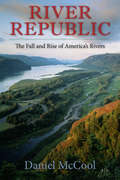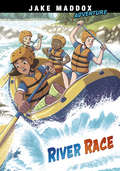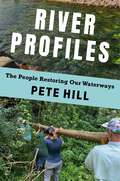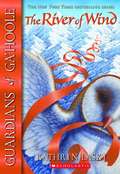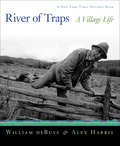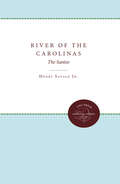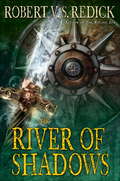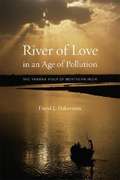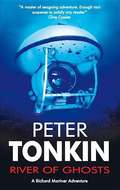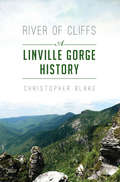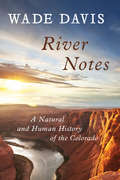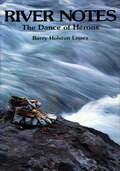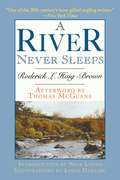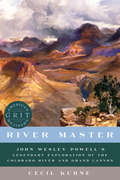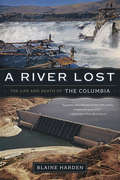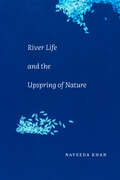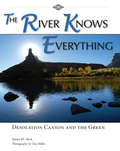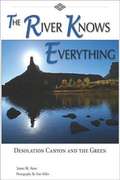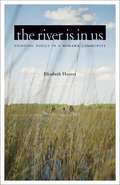- Table View
- List View
River Republic: The Fall and Rise of America's Rivers
by Daniel McCoolDaniel McCool not only chronicles the history of water development agencies in America and the way in which special interests have abused rather than preserved the country's rivers, he also narrates the second, brighter act in this ongoing story: the surging, grassroots movement to bring these rivers back to life and ensure they remain pristine for future generations. The culmination of ten years of research and observation, McCool's book confirms the surprising news that America's rivers are indeed returning to a healthier, free-flowing condition. The politics of river restoration demonstrates how strong grassroots movements can challenge entrenched powers and win. Through passion and dedication, ordinary people are reclaiming the American landscape, forming a "river republic" of concerned citizens from all backgrounds and sectors of society. As McCool shows, the history, culture, and fate of America is tied to its rivers, and their restoration is a microcosm mirroring American beliefs, livelihoods, and an increasing awareness of what two hundred years of environmental degradation can do. McCool profiles the individuals he calls "instigators," who initiated the fight for these waterways and, despite enormous odds, have succeeded in the near-impossible task of challenging and changing the status quo. Part I of the volume recounts the history of America's relationship to its rivers; part II describes how and why Americans "parted" them out, destroying their essence and diminishing their value; and part III shows how society can live in harmony with its waterways while restoring their well-being—and, by extension, the well-being of those who depend on them.
A River Ran Wild: An Environmental History
by Lynne CherryAn environmental history of the Nashua River, from its discovery by Indians through the polluting years of the Industrial Revolution to the ambitious cleanup that revitalized it.
River Race (Jake Maddox Adventure)
by Jake MaddoxNate, Selena, Tyson, and Alicia are ready for summer. But when Nate convinces everyone to join a white water rafting race, the group’s teamwork is put to the test. Will these four friends make it past the finish line? Or will their competitive nature sink their chances?
River Profiles: The People Restoring Our Waterways
by Pete HillCenturies of mismanagement and destructive development have gravely harmed American waterways, with significant consequences for the ecosystems and communities built around them. But a range of passionate and committed people have stepped up to restore streams and rivers around the United States. A husband-and-wife scientist team in Pennsylvania lead projects to unclog the sediment left by early colonists’ dams. Members of the Tulalip Tribes in western Washington State bring beavers back to headwater streams. A public servant in Milwaukee drives the sewer department to remove concrete channels and reduce flood risk. Community activists in Atlanta push for environmental justice in river restoration.Telling these stories and many more, Pete Hill—a twenty-year veteran of the field of watershed restoration—provides a deep dive into the world of river and stream conservation. He profiles the practitioners, scientists, and activists from all walks of life who take part in restoration efforts, exploring their differing, sometimes controversial approaches. Through their stories, Hill illustrates the challenges and rewards of river restoration and the evolving scientific understanding in the field. Underscoring the need for a variety of strategies adapted to different local contexts, he shows that new ideas have come from a wide range of people—from those operating the machinery to those researching stream ecology—and that Indigenous knowledge offers vital resources. At once personal and learned, insightful and inspiring, this book shines a light on the people working to heal our streams and rivers.
River Otter (Nature's Children)
by Laima DingwallDid you know... that river otters are considered the clowns of the animal kingdom; that otters do not hibernate but will play, swim and live out their winters under the ice; and that otters use tools to eat their food. Find out lots of exciting facts about this wonderful creature.
The River of Wind (Guardians of Ga'Hoole #13)
by Kathryn LaskyIn this Guardians of Ga'Hoole Series Book 13, Coryn and the Band have returned to the Great Ga'Hoole Tree and restored order. With the Ember safely hidden away, the tree shakes off its gaudy golden glow and recovers its natural majesty.
River of Traps
by Alex Harris William DebuysNew Mexico's Sangre de Cristo mountains are a place where two cultures - Hispanic and Anglo - meet. They're also the place where three men meet: William deBuys, a young writer; Alex Harris, a young photographer; and Jacobo Romero, an old farmer. When Harris and deBuys move to New Mexico in the 1970s, Romero is the neighbor who befriends them and becomes their teacher. With the tools of simple labor - shovel and axe, irony and humor - he shows them how to survive, even flourish, in their isolated village. A remarkable look at modern life in the mountains, River of Traps also magically evokes the now-vanished world in which Romero tended flocks on frontier ranges and absorbed the values of a society untouched by cash or Anglo America. His memories and wisdom, shared without sentimentality, permeate this absorbing story of three men and the place that forever shaped their lives.
River of the Sacred Monkey
by Dimitar KrustevAn authentic chronicle of wilderness river exploration in Central America, with a valid portrayal of the last remaining descendants of the vanishing Mayans.
River of the Carolinas: The Santee
by Henry SavageThe story of the Santee is, in fact, the story of a major part of the Carolinas east of the Appalachians, for the river drains an immense area of both states from the mountains to the ocean. Savage also describes fully the change-over from the agricultural Old South to the industrial New South, a change sparked largely by the hydroelectric power of the Santee.Originally published in 1968.A UNC Press Enduring Edition -- UNC Press Enduring Editions use the latest in digital technology to make available again books from our distinguished backlist that were previously out of print. These editions are published unaltered from the original, and are presented in affordable paperback formats, bringing readers both historical and cultural value.
The River of Shadows
by Robert V. RedickIn the gripping sequel to Robert V. S. Redick's acclaimed epic fantasy novels The Red Wolf Conspiracy and The Ruling Sea, the crew of the vast, ancient ship Chathrand have reached the shores of the legendary southern empire of Bali Adro. Many have died in the crossing, and the alliance of rebels, led by the tarboy Pazel Pathkendle and the warrior Thasha Isiq, has faced death, betrayal, and darkest magic. But nothing has prepared them for the radically altered face of humanity in the South. They have little time to recover from the shock, however. For with landfall, the battle between the rebels and centuries-old sorcerer Arunis enters its final phase. At stake is control of the Nilstone, a cursed relic that promises unlimited power to whoever unlocks the secrets of its use--but death to those who fail. And no one is closer to mastering the Stone than Arunis. Desperate to stop him, Pazel and Thasha must join forces with their enemies, including the depraved Captain Rose and the imperial assassin Sandor Ott. But when a suspicious young crewmember turns his attentions to Thasha, it is the young lovers themselves who are divided--most conveniently for Arunis. As the mage's triumph draws near, the allies face a terrible choice: to break their oaths and run for safety, or to hunt the world's most dangerous sorcerer through the strange and deadly dream kingdom known as the River of Shadows, and to face him a last time among the traps and horrors of his lair. Brimming with high adventure, dark enchantment, and unforgettable characters, The River of Shadows deftly secures Redick's place in the ranks of epic fantasy's most original and enthralling storytellers.From the Hardcover edition.
River Of Love In An Age Of Pollution: The Yamuna River Of Northern India
by David L. HabermanCelebrated as an aquatic form of divinity for thousands of years, the Yamuna is one of India's most sacred rivers. A prominent feature of north Indian culture, the Yamuna is conceptualized as a goddess flowing with liquid love -- yet today it is severely polluted, the victim of fast-paced industrial development. <P> This fascinating and beautifully written book investigates the stories, theology, and religious practices connected with this river goddess collected from texts written over several millennia, as well as from talks with pilgrims, priests, and worshippers who frequent the pilgrimage sites and temples located on her banks. <P> David L. Haberman offers a detailed analysis of the environmental condition of the river and examines how religious practices are affected by its current pollution. He introduces Indian river environmentalism, a form of activism that is different in many ways from its western counterpart. River of Love in an Age of Pollution concludes with a consideration of the broader implications of the Yamuna's plight and its effect on worldwide efforts to preserve our environment.
River of Ghosts (Richard Mariner Adventure #20)
by Peter TonkinDeep in the darkest reaches of the East China Sea, the remote vessel Neptune edges through the utter blackness along the Ryuku Trench, guided by the steady hands of Richard and Robin Mariner. The Mariners are actually five thousand metres above Neptune. They are seated side by side in the virtual environment presented by the vehicle control room of Poseidon, testing their company Heritage Mariner's latest acquisition. Suddenly a distress call comes in. A submarine has become trapped on the seabed nearby and its crew are rapidly running out of air. The trapped submarine has been on news networks for the last few days as its widely publicized mission is to recover a fortune in gold lost aboard the greatest of Kublai Khan's huge treasure ships, which sailed for Japan in 1281 and vanished without trace. But as the Mariners and their associates guide Neptune to the rescue of the submariners trapped far below, a different, darker, story becomes plain. Was the submarine's voyage simply a cover for another, more sinister, mission?
River of Dust: The Life-Giving Link Between North Africa and the Amazon
by Jilanne HoffmannOver and Under the Rainforest meets This Is How We Do It in A River of Dust—a celebration of global interconnectedness with an environmental lens, at a time when we need it most.I am dust,the dust of North Africa.I connect continents. The dust of the Sahel—a ribbon of land between the Sahara and the savannah—lifts with the harmattan wind each winter season. But this is not just any dust. The Sahel's dust will mix with dust from the Sahara and travel thousands of miles westward, across the African continent and the Atlantic Ocean, to reunite with its unforgotten home deep in the Amazon basin. Told in the perspective of dust, A River of Dust takes readers on a journey through vibrantly illustrated landscapes, celebrating the power and wonder of Earth's ecosystems, and showing how these tiny particles are in fact key to the health of our planet. Meticulously researched and lushly illustrated, this picture book is a lyrical ode to global interconnectedness and the vital roles that even the smallest play in taking care of our planet.GLOBAL CONNECTIVITY: Just like This Is How We Do It, this book emphasizes global connectivity: the Amazon can't succeed by itself, and we all have a role to play.SMALL PARTICLES, MIGHTY IMPACT: This powerful story of the Sahel's very necessary contribution to the world demonstrates how seemingly inconsequential particles are key to the health of our planet. And if dust can be so important, readers will imagine the impact each one of them can have on the world around them.EDUCATIONAL TOOL: With strong STEM themes, this offers plenty of opportunities to incorporate into lesson plans, from units on geography and environmental science, particularly lessons on the rainforest, global warming, and interconnected ecosystems.SOOTHING LULLABY: Poetic and yearning, this picture book has a gentle message that reassures its readers about remaining connected despite time and distance with an affirmation of love that parents will enjoy sharing with their children.ARTFUL & LUSH: Vivid landscapes, from the deserts of Africa to the rainforests of the Amazon, by illustrator Eugenia Mello, make this lyrical picture book come to life. Note the gorgeous spattering of foil dust on the jacket, which makes this cover glow!WANT TO LEARN MORE?: Meticulously researched information included at the back of the book provides insight and compelling scientific facts for readers who are curious to know more. Did you know that there are more trees in the Amazon than stars in the Milky Way galaxy?Perfect for:Resource for teachers and librarians seeking books about nature, the earth, and ecology for kidsParents looking for non-fiction picture books and science books for childrenA beautiful environmental picture book and lyrical story for anyone interested in learning about ecosystems and the environmentFans of Over and Under the Rainforest, Over and Under the Pond, and other popular nature books for young readers
River of Cliffs: A Linville Gorge History
by Christopher BlakeLinville Gorge was the first Wilderness Area on the East Coast, approved by Congress in 1964. “The Grand Canyon of the East” was named for William Linville, a member of a party of long hunters in 1766 who fell victim to a Shawnee attack. The difficult terrain made early settlements nearly impossible and logging unprofitable, and it remains one of the few examples of old-growth forest in the Blue Ridge Mountains. Unique rock formations, from Table Rock to the Chimneys, and miles of trails attract thousands of climbers, hikers and adventure seekers each year. In this revised edition, author Christopher Blake draws on American colonial reports, travel writings, diaries, fiction and numerous archival records to weave a narrative fabric of an American treasure.
River Notes: A Natural and Human History of the Colorado
by Wade DavisPlugged by no fewer than twenty-five dams, the Colorado is the world's most regulated river drainage. The Colorado River provides most of the water supply of Las Vegas, Tucson, and San Diego, and much of the power and water of Los Angeles and Phoenix, cities that are home to more than 25 million people. If it ceased flowing, the water held in its reservoirs might hold out for three to four years, but after that it would be necessary to abandon most of southern California and Arizona, and much of Colorado, New Mexico, Utah and Wyoming. For the entire American Southwest the Colorado is indeed the river of life, which makes it all the more tragic and ironic that by the time it approaches its final destination, it has been reduced to a shadow upon the sand, its delta dry and deserted, its flow a toxic trickle seeping into the sea. In this remarkable blend of history, science, and personal observation, acclaimed author Wade Davis tells the story of America's Nile, how it once flowed freely and how human intervention has left it near exhaustion, altering the water temperature, volume, local species, and shoreline of the river Theodore Roosevelt once urged us to "leave it as it is." Yet despite a century of human interference, Davis writes, the splendor of the Colorado lives on in the river's remaining wild rapids, quiet pools, and sweeping canyons. The story of the Colorado River is the human quest for progress and its inevitable if unintended effects--and an opportunity to learn from past mistakes and foster the rebirth of America's most iconic waterway. A beautifully told story of historical adventure and natural beauty, River Notes is a fascinating journey down the river and through mankind's complicated and destructive relationship with one of its greatest natural resources.
River Notes: The Dance of Herons
by Barry Holstun LopezAn acclaimed nature writer evokes and celebrates the forces, settings, rituals, movements, and imperatives of a river, as it calls us back to unity with the natural world.
A River Never Sleeps
by Thomas Mcguane Nick Lyons Louis Darling Roderick L. Haig-BrownFew books have captured the haunting world of music and rivers and of the sport they provide as well as A River Never Sleeps. Roderick L. Haig-Brown writes of fishing not just as a sport, but also as an art. He knows moving water and the life within it-its subtlest mysteries and perpetual delights. He is a man who knows fish lore as few people ever will, and the legends and history of a great sport.Month by month, he takes you from river to river, down at last to the saltwater and the sea: in January, searching for the steelhead in the dark, cold water; in May, fishing for bright, sea-run cutthroats; and on to the chilly days of October and the majestic run of spawning salmon. All the great joy of angling is here: the thrill of fishing during a thunderstorm, the sight of a river in freshet or a river calm and hushed, the suspense of a skillful campaign to capture some half-glimpsed trout or salmon of extraordinary size, and the excitement of playing and landing a momentous fish.A River Never Sleeps is one of the enduring classics of angling. It will provide a rich reading experience for all who love fishing or rivers.
River Master: John Wesley Powell's Legendary Exploration Of The Colorado River And Grand Canyon (American Grit #0)
by Cecil KuhneExperience John Powel's now-famous expedition through the Grand Canyon In 1869, Civil War veteran and amputee Major John Wesley Powell led an expedition down the uncharted Colorado River through the then-nameless Grand Canyon. This is the story of what started as a geological survey, but ended in danger, chaos, and blood. The men were inexperienced and ill-equipped, and they faced unimaginable peril. Along the way there was death, mutiny, and abject terror, but Powell persevered and produced a masterwork of adventure writing still held in the highest regard by the boatmen who follow his course today. With never-before-used primary sources and firsthand experience navigating Powell’s legendary route, Cecil Kuhne brings this remarkable chapter of frontier history to life. The American Grit series brings you true tales of endurance, survival, and ingenuity from the annals of American history. These books focus on the trials of remarkable individuals with an emphasis on rich primary source material and artwork.
A River Lost: The Life and Death of the Columbia (Revised and Updated)
by Blaine Harden"Superbly reported and written with clarity, insight, and great skill." --Washington Post Book World After two decades, Washington Post journalist Blaine Harden returned to his small-town birthplace in the Pacific Northwest to follow the rise and fall of the West's most thoroughly conquered river. To explore the Columbia River and befriend those who collaborated in its destruction, he traveled on a monstrous freight barge sailing west from Idaho to the Grand Coulee Dam, the site of the river's harnessing for the sake of jobs, electricity, and irrigation. A River Lost is a searing personal narrative of rediscovery joined with a narrative of exploitation: of Native Americans, of endangered salmon, of nuclear waste, and of a once-wild river. Updated throughout, this edition features a new foreword and afterword.
River Life and the Upspring of Nature
by Naveeda KhanIn River Life and the Upspring of Nature Naveeda Khan examines the relationship between nature and culture through the study of the everyday existence of chauras, the people who live on the chars (sandbars) within the Jamuna River in Bangladesh. Nature is a primary force at play within this existence as chauras live itinerantly and in flux with the ever-changing river flows; where land is here today and gone tomorrow, the quality of life itself is intertwined with this mutability. Given this centrality of nature to chaura life, Khan contends that we must think of nature not simply as the physical landscape and the plants and animals that live within it but as that which exists within the social and at the level of cognition, the unconscious, intuition, memory, embodiment, and symbolization. By showing how the alluvial flood plains configure chaura life, Khan shows how nature can both give rise to and inhabit social, political, and spiritual forms of life.
The River Knows Everything: Desolation Canyon and the Green
by James M AtonDesolation Canyon is one of the West's wild treasures. Visitors come to study, explore, run the river, and hike a canyon that is deeper at its deepest than the Grand Canyon, better preserved than most of the Colorado River system, and full of eye-catching geology-castellated ridges, dramatic walls, slickrock formations, and lovely beaches. Rafting the river, one may see wild horses, blue herons, bighorn sheep, and possibly a black bear. Signs of previous people include the newsworthy, well-preserved Fremont Indian ruins along Range Creek and rock art panels of Nine Mile Canyon, both Desolation Canyon tributaries. Historic Utes also pecked rock art, including images of graceful horses and lively locomotives, in the upper canyon. Remote and difficult to access, Desolation has a surprisingly lively history. Cattle and sheep herding, moonshine, prospecting, and hideaways brought a surprising number of settlers--ranchers, outlaws, and recluses--to the canyon.
The River Knows Everything
by James M. AtonDesolation Canyon is one of the West's wild treasures. Visitors come to study, explore, run the river, and hike a canyon that is deeper at its deepest than the Grand Canyon, better preserved than most of the Colorado River system, and full of eye-catching geology-castellated ridges, dramatic walls, slickrock formations, and lovely beaches. Rafting the river, one may see wild horses, blue herons, bighorn sheep, and possibly a black bear. Signs of previous people include the newsworthy, well-preserved Fremont Indian ruins along Range Creek and rock art panels of Nine Mile Canyon, both Desolation Canyon tributaries. Historic Utes also pecked rock art, including images of graceful horses and lively locomotives, in the upper canyon. Remote and difficult to access, Desolation has a surprisingly lively history. Cattle and sheep herding, moonshine, prospecting, and hideaways brought a surprising number of settlers--ranchers, outlaws, and recluses--to the canyon.
The River Is in Us: Fighting Toxics in a Mohawk Community
by Elizabeth HooverMohawk midwife Katsi Cook lives in Akwesasne, an indigenous community in upstate New York that is downwind and downstream from three Superfund sites. For years she witnessed elevated rates of miscarriages, birth defects, and cancer in her town, ultimately drawing connections between environmental contamination and these maladies. When she brought her findings to environmental health researchers, Cook sparked the United States’ first large-scale community-based participatory research project.In The River Is in Us, author Elizabeth Hoover takes us deep into this remarkable community that has partnered with scientists and developed grassroots programs to fight the contamination of its lands and reclaim its health and culture. Through in-depth research into archives, newspapers, and public meetings, as well as numerous interviews with community members and scientists, Hoover shows the exact efforts taken by Akwesasne’s massive research project and the grassroots efforts to preserve the Native culture and lands. She also documents how contaminants have altered tribal life, including changes to the Mohawk fishing culture and the rise of diabetes in Akwesasne.Featuring community members such as farmers, health-care providers, area leaders, and environmental specialists, while rigorously evaluating the efficacy of tribal efforts to preserve its culture and protect its health, The River Is in Us offers important lessons for improving environmental health research and health care, plus detailed insights into the struggles and methods of indigenous groups. This moving, uplifting book is an essential read for anyone interested in Native Americans, social justice, and the pollutants contaminating our food, water, and bodies.
The River Horse
by Nina Ames FreyEvery child wants a horse, and Arana, a young Mayan Indian boy living in a Guatemalan village, is no exception. From his grandfather he hears tales of his people's past greatness. He hears, too, stories of how the Spanish soldiers came, mounted on their horses, and conquered his ancestors, who had never seen horses and were afraid. One day in the forest with his father he sees a danta, a little wild animal native to Guatemala that is known as a river horse. Arana returns to the forest on his own to try to capture the little danta and have the rare river horse for his own.
